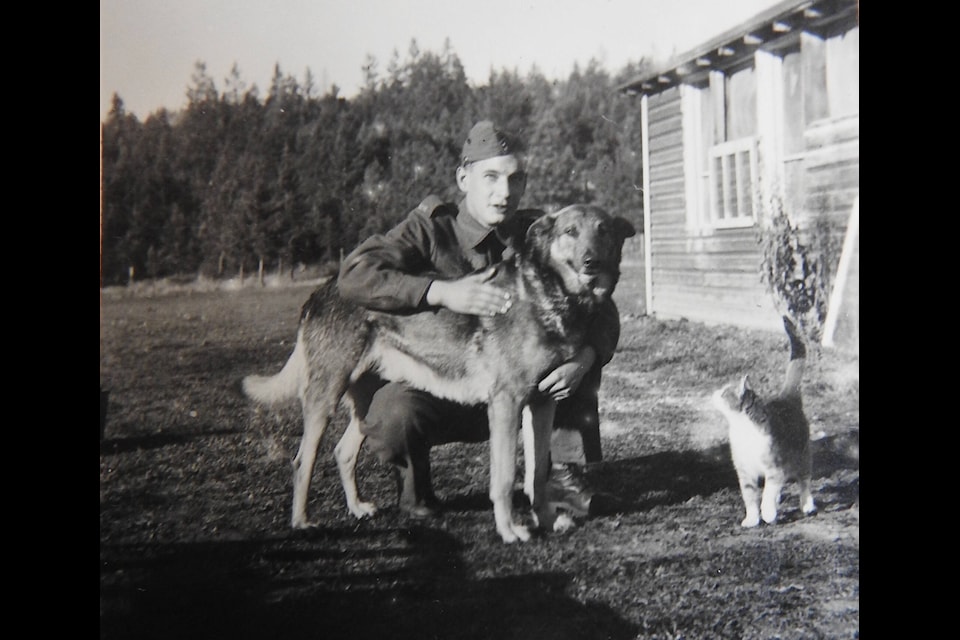A sailing trip off the coast of Europe ended with a Fernie family discovering its own close connection to one of the Second World War’s most important battles.
In July, Deryk and Sara Yuill and their daughter Emily set off on a two-month journey in the North Sea and neighbouring English Channel in their boat, First Tracks. A chance meeting with tourists led them to Juno Beach in France, where they discovered that Deryk’s uncle Ronald Brewer had fought and died in the Second World War.
“We didn’t really have a plan other than we were on the boat for two months and we were generally headed west, with the goal of getting some distance into France,” Deryk explained. “We were going to see some things in Belgium, see some things in France. [We] didn’t really know what those things were going to be. We were just going to enjoy the summer.”
Juno Beach is one of several beaches along the Normandy coastline of France that was the site of the D-Day invasions. On the morning of June 6, 1944, troops from England, Canada and the U.S descended on the coastal beaches to attack German blockhouses. This would mark the beginning of a series of military campaigns that allowed allied forces to gain a foothold in Europe.
The Yuills didn’t know about the family connection until they set foot on the beach.
“Deryk knew his uncle died in the war, but he didn’t know when and where. He knew his uncle was on the [Fernie] cenotaph, but it wasn’t really talked about ever,” said Sara.
Plans for the fateful trip were set in motion when the Yuills ran into some English sailors in Boulogne-sur-Mer, who were keen to visit the beaches.
“They had this plan of going to the beaches and taking some pictures with this old flag that they had…,” Deryk recalled. “Their plan kind of fit pretty well in with what I thought we needed to do to wrap up the summer.”
The Yuills sailed to Ouistreham and boarded a bus to Juno. They toured the Juno Beach Centre — a museum dedicated to the soldiers that fought there — and visited the German bunkers on the beach.
During their visit, Deryk suddenly had the urge to look up his uncle’s name on his phone to see if he could find where he had fought and died. To his surprise he discovered that his uncle, Ronald Brewer, had spent his final moments on the very beach they were exploring.
They also discovered that he was buried only a few kilometres away from Juno Beach, in Graye-sur-Mer Cemetery. A Canadian-born traveller who was familiar with the area offered to take them to his grave.
Deryk said that learning about the family connection helped him understand the conflict better.
“You start to really appreciate the importance and the magnitude of D-Day…,” he said. “I hadn’t really considered everything that it meant, the scale of the undertaking. That was the day the good guys started to win.”
Fernie research project provides further information
The family’s discovery dovetailed with a history project headed up by two local women back in Fernie, which sought to uncover details about the soldiers listed on the local cenotaph.
Fernie resident Sylvia Ayers launched the project back in 2018 as a way of commemorating First and Second World War veterans. She sought the help of Fernie Museum curator Lindsay Vallance, who began researching the men on the cenotaph, including Ronald Brewer.
READ MORE:
Between the journey to France and the research project, a story of Brewer’s life has begun to emerge.
Ronald Norman Brewer was born Aug. 1, 1922 in Travis, Alta., to Fernie carpenter Sidney Edmund Brewer and Fuller Brush Company employee Ilah Brewer. Brewer worked on his uncle’s chicken farm before enlisting for service on July. 21, 1941 in Cranbrook. He served as a sapper (combat engineer), blacksmith and driver for the Royal Canadian Engineers. He was killed by mortar fire on June 6, 1944 during the landing at Juno Beach.
“He was wounded by machine gun fire on the beach. Fifteen minutes later, he was killed by a mortar shell. His body was washed out to sea by the tide, but later recovered and he was buried,” said Deryk.
Deryk’s mother Beverly Yuill was pleased with the discovery. She was only a young girl when her brother Ronald died, and all she had of him was a few photos.
“It just made me feel that this was all a reality. It wasn’t just in pictures,” she said.
Beverly currently resides in Cranbrook, although she was raised in Fernie. She remembers accompanying her father to the Fernie Station to watch Brewer and other soldiers pass through on a train. The soldiers were not allowed to get off and visit with their families, but they were able to wave from the window.
“Ron was able to get a seat by the window. I guess any of the Fernie boys were able to do that so the families could see them,” she said.
The family kept in touch with Brewer from overseas.
“I remember letters going back and forth between my sister, who was 13 years older than me,” said Beverly. “I remember her sending parcels and she would sew a cloth all around it because the paper could rip. I remember her stitching this up and mailing it. I think there was some baking in it.”
The family received a telegram alerting them of Brewer’s death and a medal was sent to them in honour of his service.
As for Deryk, he has found that learning about his uncle’s story has made him much more interested in the history of the Second World War.
“I started getting a lot more engaged in the history … I found this really quite engaging and having this connection made it that much more so,” he said.




